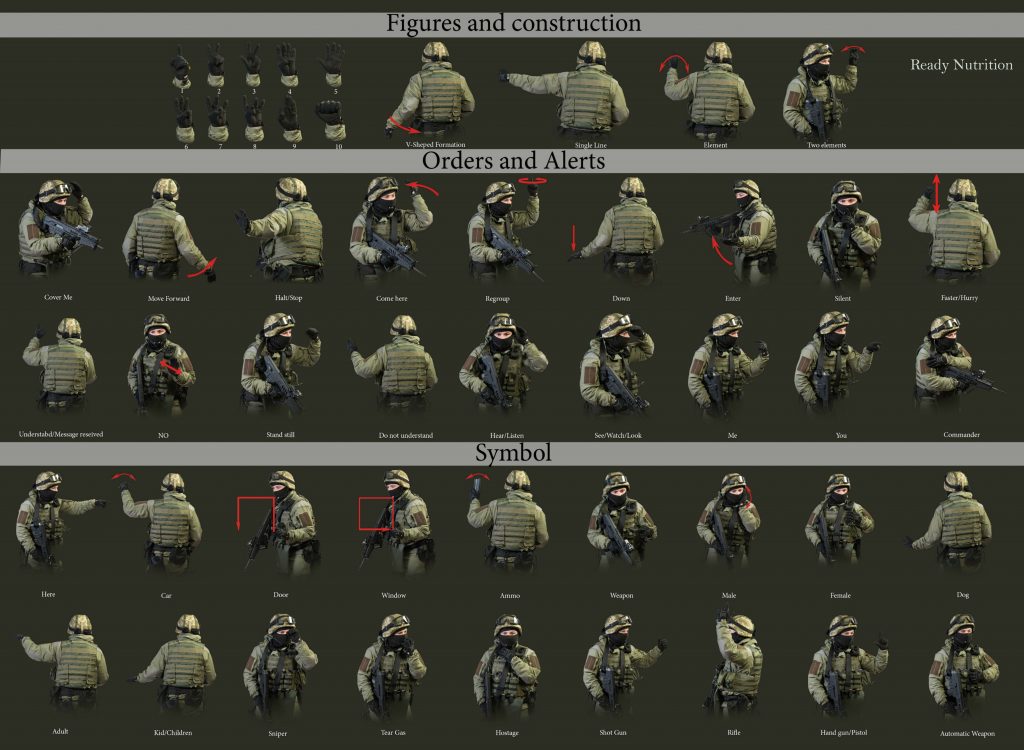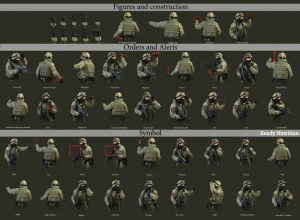Law enforcement, corrections, probation, and military Special Operations teams worldwide use hand signals to communicate in the field to lessen their risk and to avoid compromising their position. Good security requires efficient forms of communication and when audible communication like speech and radio comms cannot be used, hand signals are a good alternative.
So, why signals?
- Helps teams communicate over near and far distances when they have to observe noise discipline [1].
- Helps small or large teams travel over terrain or through structures in a more organized manner.
- Helps to keep track of team members.
- Helps teams to move stealthily when noise discipline must be maintained.
- Helps teams move as a group even when noise discipline is no longer an issue, such as moving units over the sound of battle or when machinery noise is deafening.
As with any communication form, there are pros and cons. While natural elements like weather and terrain restrict your ability to effectively use this form of communication, the best time to use hand signals is if your group is nearby and in need of masking their presence from an enemy. Keep in mind that hand signals can be misunderstood because you or group members may be at a distance or maybe in a confusing situation with lots of noise, therefore use clear, concise and exaggerated movements to help people understand what the next move is. Moreover, when you are making these signals, face your body directly at the person you are giving signals to so they can see them clearly. When you receive the signals always acknowledge with either “Yes” “No,” or “I don’t understand”
Learning hand signals is simpler than one would think, and at times, common sense. Keep in mind that hand signals can be misunderstood because you or group members may be at a distance or maybe in a confusing situation with lots of noise, therefore use clear, concise and exaggerated movements to help people understand what the next move is. Moreover, when you are making these signals, face your body directly at the person you are giving signals to so they can see them clearly. When you receive the signals always acknowledge with either “Yes” “No,” or “I don’t understand”
Some of the most common signals you will use in the field are:
-
- Yes
- No
- I understand
- Stop
- Freeze
- Get down
- Stand up and move out
- Enemy
- I see the enemy
- I hear the enemy
- Cover me
- Move to another observation point
 [2]*Click on image for larger version. Then click on full-size option
[2]*Click on image for larger version. Then click on full-size option
What you will find in the following videos are the basic tactical hand signals used by law enforcement and military personnel. For more information, this Army Field Guide [3] provides a more in-depth look at visual signals.
Tactical Hand Signals, Part 1
Tactical Hand Signals, Part 2
Practice Makes Perfect
As with everything, the more you practice this essential skill, the better and more effective you will be at communicating in silence. To move effectively, a group should consistently practice tactical hand signals. In fact, the more you use hand signals with a group, chances are you will come up with your own signaling moves.
Printing out the hand signals and keeping it stashed in your pack is another way to review the signals and correctly use them.
